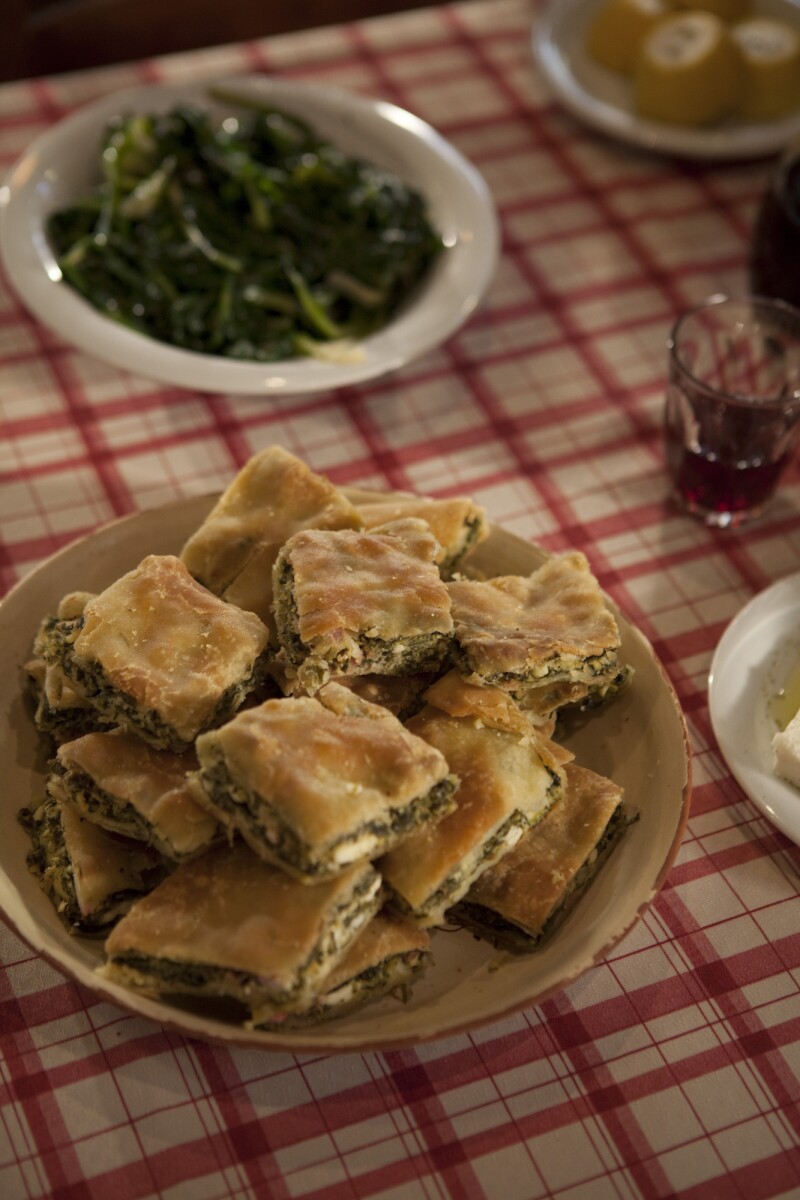Paring knife in one hand, empty plastic bag in the other, I am following my friend Lakis as he climbs along a narrow goat path through thorny brush to a meadow he promises will yield tasty rewards. We are high on a mountain plateau in the southeastern part of Greece’s Peloponnese peninsula, and we are in search of horta—edible wild greens. Scores of species grow throughout Greece, including sow thistle, sea lavender, and black nightshade. Greeks prize horta for their health benefits and range of flavor, from mild to pungent and sometimes slightly bitter. In the tiny village of Poulithra, where I live, foraging for horta is a serious pastime. Lakis has gathered greens in these mountains for most of his 55 years.
Many Greeks keep a knife and bags stashed in their cars for spontaneous gathering of greens—be it from a pristine mountainside or along the edge of a busy road in suburban Athens. Knowledge of the plants and their use is passed down from generation to generation. My friend Lakis learned to identify our local species from his mother, Panagiota, who, at 90 years old, still ambles up a well-worn footpath through the carob and olive groves above Poulithra to gather her favorite greens.
Panagiota knows exactly what she is looking for. As a novice, I need time for my eyes to adjust to the task—to distinguish the horta we are seeking from the hortaria, or grasses, best left to the goats.
In Poulithra, a wintertime staple is hortopita, a hearty pie related to the better-known spanakopita. It is made with layers of homemade phyllo, wild greens, aromatic herbs such as dill and parsley, and touloumotiri, a rustic cheese made from both goat’s and sheep’s milk, considered the mother of feta. Patra Hiotis, my friend and neighbor in Poulithra, bakes hortopita in the wood-fired oven in her garden on the same day she bakes her week’s supply of bread.
Those not willing to go in search of horta pay a premium at farmers’ markets and produce stands for the many varieties of wild greens available. During horta-gathering season, from late fall to midspring, virtually every taverna in the countryside serves horta apo ta vouna—a mix of greens boiled and then topped with fruity olive oil, lemon, and salt— as a side dish. Chefs also add greens to stews, soups, and bean dishes, or braise them with lamb or goat.
According to myth, Theseus, the hero and founder-king of Athens, was served a fortifying plate of horta before taking on the bull at Marathon. I prefer my greens tucked into a hand-rolled crust, baked in an outdoor oven, and enjoyed with a glass of homemade retsina, the resin-flavored white or rosé Greek wine. Some restaurants and bakeries offer hortopita, but if you can’t travel to Greece—and if you don’t have access to a yia-yia (Greek grandmother)—the next best thing is to make it yourself.

Photo by Chryssa Nikoleri
How to Make Hortopita
Makes 1 pie, Serves 8 to 10
Adapted from the home recipe of Patra Hiotis
Ingredients
- 1⁄2 cup olive oil
- 4 to 5 leeks or 16 scallions, chopped
- 6 cloves garlic, minced
- 2 pounds mixed wild greens (such as dandelion and purslane) or Swiss chard, chopped
- 1 cup each fresh dill, mint, and parsley, minced
- Salt
- Freshly ground black pepper
- 12 ounces feta cheese, crumbled
- 6 13-x-17-inch rectangular sheets of phyllo dough
Instructions
- Heat olive oil in a pan over medium-high heat. Add the leeks or scallions and garlic; cook, stirring, until tender.
- Add the greens and herbs; cook, stirring well to wilt evenly, until soft.
- Season with salt and pepper to taste (keeping in mind that the cheese will add salt); let cool.
- Stir in the feta; set aside.
- Preheat oven to 400°F.
- Grease a 2-inch deep, 9-x-13-inch baking pan with olive oil.
- Lay one phyllo sheet into the pan, allowing the edges to hang over.
- Brush the phyllo with oil.
- Lay a second dough sheet on top of the first sheet, and brush with oil.
- Spread one third of the greens mixture onto the phyllo in the pan.
- Place another phyllo sheet on top of the greens; cover with half the remaining greens
- Repeat step 11, using the remaining greens.
- Cover the greens with one more sheet of phyllo, brush with oil, and top with last sheet.
- Pinch the phyllo that spills over the pan’s edge to create a decorative rim.
- Score the top with a sharp knife to vent.
- Bake for 20 minutes.
- Reduce the heat to 350°F and bake until the crust is golden and pulls away from the pan’s edge (18–20 minutes).
- Let the pie cool to room temperature before slicing and serving.
This article originally appeared online in February 2012; it was updated in December 2017 to include current information.
>>Next: 10 Tips for Eating Healthy on the Road










